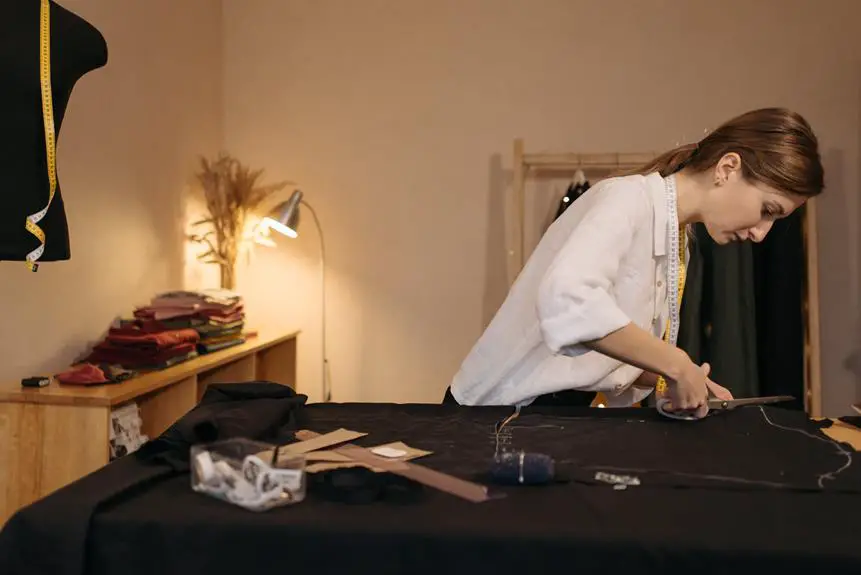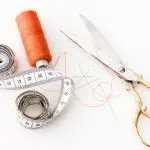When it comes to the art of cutting fabric, the choice between fabric shears and scissors holds significant weight. Understanding the nuances of each tool is essential for precision and mastery in your craft.
You'll explore the unique features and advantages of fabric shears and scissors, as well as the key considerations for selecting the best cutting tool for your specific project.
Additionally, you'll delve into the best practices for utilizing fabric shears and scissors to achieve impeccable results. By examining the distinct qualities of these cutting implements, you'll gain a deeper understanding of their functionality and be equipped to make informed decisions that elevate the quality of your work.
Key Takeaways
- Fabric shears have longer blades for smooth cutting, while scissors have shorter blades and are for general-purpose cutting.
- Fabric shears are designed for cutting multiple layers of fabric, while scissors are suitable for various cutting tasks.
- Fabric shears provide clean, precise cuts for delicate fabrics and have an ergonomic design for comfort during extended cutting sessions.
- Scissors are portable and versatile, offering precise control for small cuts and the ability to maneuver around curves for intricate projects.
The Differences Between Fabric Shears and Scissors
Do you know why fabric shears and scissors are different?
Fabric shears and scissors may look similar, but they serve different purposes in the realm of cutting tools for fabrics. Fabric shears, also known as dressmaking shears, are designed with longer blades and bent handles, allowing them to glide smoothly along the fabric without lifting it from the cutting surface. They provide clean, precise cuts and are ideal for cutting through multiple layers of fabric.
On the other hand, regular scissors have shorter blades and are designed for general-purpose cutting tasks. When it comes to using cutting tools for fabric, it's crucial to understand the differences between fabric shears and scissors to achieve the best results in your projects.
In addition to understanding the differences between fabric shears and scissors, it's important to consider proper maintenance of cutting tools. Keeping your fabric shears and scissors clean and sharp is essential for optimal performance. Regularly sharpening the blades and avoiding cutting materials that can dull or damage them will prolong the life of your cutting tools. This attention to maintenance will ensure that your fabric cutting tools remain effective and reliable.
For some, rotary cutters are also a preferred cutting tool, and while they've their advantages, understanding the nuances between fabric shears, scissors, and rotary cutters is essential for mastering the art of cutting fabric.
Advantages of Using Fabric Shears
When it comes to using fabric shears, you'll find that they provide clean, precise cuts that are essential for working with delicate fabrics.
Their ergonomic design also offers comfort during extended cutting sessions, reducing strain on your hands and wrists.
These advantages make fabric shears an indispensable tool for any sewing or crafting project.
Clean, Precise Cuts
To achieve clean, precise cuts in your fabric projects, fabric shears are the superior choice over scissors. Fabric shears offer several advantages for achieving professional finishing touches and efficient cuts:
- Sharpness: Fabric shears are designed with razor-sharp blades that effortlessly slice through fabric, ensuring neat edges.
- Blade Length: The longer blades of fabric shears allow for smooth, continuous cutting, reducing the need for multiple cuts.
- Ergonomic Design: The ergonomic handles of fabric shears provide better control and comfort, resulting in steadier cutting motions.
- Fabric Compatibility: Fabric shears are specifically engineered to cut through various types of fabrics, from delicate silk to heavy denim.
- Reduced Fraying: The precise cutting action of fabric shears minimizes fraying, preserving the integrity of the fabric edges.
When aiming for pristine, professional results, fabric shears are the essential tool for achieving clean, precise cuts.
Ergonomic Design for Comfort
For comfortable and precise cutting, fabric shears offer an ergonomic design that provides optimal control and reduces hand strain. The ergonomic handles of fabric shears are specifically crafted to provide a comfortable grip, allowing for extended use without experiencing hand fatigue. The design of the handles allows for a natural hand position, reducing strain on the hand and wrist. This is especially beneficial for those who spend long hours cutting fabric. The handles are typically larger and have a wider finger brace, which distributes pressure more evenly, reducing the risk of discomfort. The ergonomic design of fabric shears not only enhances comfort but also promotes greater accuracy and efficiency in cutting fabric, making them the preferred choice for professionals and hobbyists alike.
| Ergonomic Design Features | Benefits |
|---|---|
| Comfortable grip | Reduced hand strain |
| Natural hand position | Enhanced control |
| Wider finger brace | Extended use without fatigue |
Advantages of Using Scissors
When it comes to cutting fabric, scissors offer several advantages. They're portable and versatile, allowing you to easily move around your workspace.
Additionally, scissors provide precise control for small cuts and are adept at maneuvering around curves, making them a valuable tool for intricate projects.
Portable and Versatile
You need a reliable, portable cutting tool that you can easily carry with you, and scissors fit the bill perfectly. Scissors offer several advantages due to their portable and versatile nature:
- Compact Size: Scissors are small and lightweight, making them easy to carry in your pocket or bag.
- No Power Source Required: Unlike some cutting tools, scissors don't need batteries or electricity, making them suitable for use anywhere.
- Multi-Purpose Functionality: They can be used for a wide range of cutting tasks, from fabric to paper to plastic, making them a versatile tool to have on hand.
- Ease of Use: Scissors are intuitive and easy to use, requiring minimal setup or maintenance.
- Storage Options: Their compact size allows for easy storage in drawers, toolboxes, or crafting kits.
Precise for Small Cuts
Scissors offer precise control for small cuts, allowing for accuracy and detail in your cutting tasks. When working on small projects or intricate designs, the ability to precisely maneuver your cutting tool is crucial.
Scissors enable you to make intricate and detailed cuts with ease, ensuring that your fabric or material is trimmed exactly as needed. The fine tips of scissors provide the dexterity required for delicate cuts, allowing you to navigate through tight corners and create precise shapes.
This level of precision is especially beneficial when working with intricate designs that demand meticulous cutting. With scissors, you have the control to execute small, detailed cuts accurately, making them an essential tool for mastering the art of precise cutting in your crafting and sewing endeavors.
Easily Maneuver Around Curves
Enabling precise maneuvering around curves, scissors provide the dexterity needed for intricate cutting tasks, ensuring accurate and detailed results. When it comes to easily maneuvering around curves, scissors offer distinct advantages over fabric shears. Here's why scissors excel in this aspect:
- Flexibility: Scissors allow for greater flexibility, making it easier to navigate around tight curves.
- Control: The fine tips of scissors provide enhanced control, allowing for precise adjustments during intricate cutting tasks.
- Versatility: Scissors can be used at various angles, adapting to the shape of the curve for seamless cutting.
- Precision: The ability to make small, controlled movements with scissors enables precise cutting along curved lines.
- Adaptability: Scissors are adept at handling a variety of cutting techniques, including notches, slits, and inward curves, with ease.
Considerations When Choosing Cutting Tools
When choosing cutting tools, how do you ensure they meet your specific fabric-cutting needs?
First, consider the material of the cutting tool. For fabric shears or scissors, stainless steel is a popular choice due to its durability and rust resistance. Proper maintenance is essential to ensure longevity and performance. Keep the cutting edges clean and free from residue to prevent snagging or uneven cuts. Regularly sharpening the blades is also crucial for maintaining sharpness and precision.
Additionally, ergonomic design plays a significant role in your choice. Look for cutting tools with comfortable handles to reduce hand fatigue during extended use. The handle size and shape should fit your hand comfortably, allowing for a natural grip and easy maneuvering. Weight distribution is another important factor to consider. Balanced tools provide better control and reduce strain on your hand and wrist.
Best Practices for Using Fabric Shears
To achieve precise cuts with fabric shears, you should always cut along the grain of the fabric to prevent fraying and ensure clean edges. When using fabric shears, it's essential to maintain a proper grip to ensure accuracy and reduce hand fatigue.
Here are some best practices for using fabric shears:
- Proper Grip: Hold the shears with your thumb in the smaller loop and the remaining fingers in the larger loop for better control and leverage.
- Cutting Along the Grain: Always cut along the grain of the fabric to prevent distortion and ensure a clean, professional finish.
- Maintenance Tips: Keep the blades clean and sharp by regularly wiping them with a soft cloth and using a dedicated sharpener to maintain their cutting precision.
- Cutting Table: Use a spacious cutting table or mat to provide a stable cutting surface and prevent the fabric from shifting during cutting.
- Cutting Direction: For smooth and accurate cuts, move the shears in a single, continuous motion rather than stopping and starting repeatedly.
Best Practices for Using Scissors
For precise cutting with scissors, maintain a firm grip and ensure the blades are sharp.
Proper grip is essential to avoid hand fatigue and ensure accuracy. Hold the scissors with your thumb in the smaller loop and the middle and index fingers in the larger loop. This grip allows for better control and reduces strain on your hand during extended use.
When cutting, pay attention to the angles at which you position the scissors. For straight cuts, keep the blades perpendicular to the material. For curved cuts, adjust the angle of the scissors to follow the desired shape accurately.
Additionally, regularly maintain the blades of the scissors to ensure clean and effortless cutting. Keep them clean and dry to prevent rust and corrosion, and sharpen them as needed to maintain their cutting precision.
Frequently Asked Questions
Can Fabric Shears Be Used for Cutting Paper or Other Materials Besides Fabric?
Yes, fabric shears can be used for cutting paper and other materials besides fabric. They are versatile tools for crafts and can provide clean, precise cuts. However, it's important to use them exclusively for alternative materials to avoid dulling the blades.
Are There Specific Maintenance Tips for Keeping Fabric Shears in Good Condition?
To keep fabric shears in optimal condition, follow specific maintenance tips. Sharpening techniques are vital for maintaining sharpness, while proper storage prevents rust. Regularly sharpen your shears using a sharpening stone and store them in a dry environment to prevent rust.
Can Left-Handed Individuals Use the Same Fabric Shears as Right-Handed Individuals?
Left-handed individuals can use fabric shears designed for either hand, but left-handed shears offer better ergonomic design. Their angled handles and blades provide improved cutting precision and comfort for left-handed users.
Are There Any Specific Safety Precautions to Keep in Mind When Using Fabric Shears?
When using fabric shears, it's crucial to follow proper handling and maintenance tips. Always keep the shears closed when not in use, and store them in a safe place. Regularly clean and lubricate the blades to ensure smooth cutting.
How Do I Know When It's Time to Sharpen or Replace My Fabric Shears?
Knowing when to sharpen or replace your fabric shears is crucial for maintaining their effectiveness. Look for signs like frayed edges or difficulty cutting through fabric. Regular maintenance tips and proper left-handed usage can prolong their lifespan.
- How Does Ring Spun Cotton Affect Garment Fit and Shape Retention? - August 13, 2024
- What Are the Challenges in Producing Ring Spun Cotton? - August 13, 2024
- Is Ring Spun Cotton Suitable for Plus-Size Clothing? - August 13, 2024







